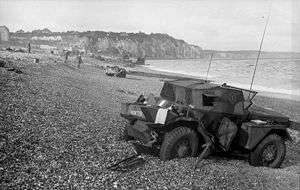Dieppe Raid
Operation Jubilee or the Dieppe Raid (19 August 1942) was an Allied amphibious attack on the German-occupied port of Dieppe, northern France in the Second World War. Over 6,050 infantry, predominantly Canadian, supported by a regiment of tanks, were put ashore from a naval force operating under protection of Royal Air Force (RAF) fighters.
The port was to be captured and held for a short period, to test the feasibility of a landing and to gather intelligence. German coastal defences, port structures and important buildings were to be demolished. The raid had the added objectives of boosting morale and demonstrating the commitment of the United Kingdom to re-open the Western front. Aerial and naval support was insufficient to enable the ground forces to achieve their objectives; the tanks were trapped on the beach and the infantry was largely prevented from entering the town by obstacles and German fire. After less than six hours mounting casualties forced a retreat; only one landing force achieved its objective.
The operation was a fiasco in which the only success was in gathering intelligence including electronic intelligence. Of the 6,086 men who landed, within ten hours, 3,623 had been killed, wounded or became prisoners of war. The Luftwaffe made a maximum effort against the landing as the RAF had expected but the RAF lost 106 aircraft (at least 32 to anti-aircraft fire or accidents), against 48 German losses. The Royal Navy lost 33 landing craft and a destroyer. The lessons of the Dieppe Raid influenced preparations for Allied seaborne operations such as the Normandy landings (Operation Overlord).
Background
Dunkirk to Dieppe
In the aftermath of the Dunkirk evacuation of the British Expeditionary Force in May 1940, the British started on the development of a substantial raiding force under the umbrella of Combined Operations Headquarters. This was accompanied by the development of techniques and equipment for amphibious warfare. In late 1941, a scheme was put forward for the landing of 12 divisions around Le Havre, assuming a withdrawal of German troops to counter Soviet success in the east. From this came Operation Rutter to test the feasibility of capturing a port by an opposed landing, the investigation of the problems of operating the invasion fleet and testing equipment and techniques of the assault.[7]
After its victory in the Battle of Britain in 1940 and the Luftwaffe having switched to night bombing in the fall of 1940, the day fighters of Royal Air Force Fighter Command were "a force without an immediate mission".[8] Without anything else to do, the day fighters of RAF Fighter Command were in the spring of 1941 deployed on a series of search-and-destroy missions of flying over France to engage the Luftwaffe in combat. In the second half of 1941, the aerial offensive over France was greatly stepped up, leading to the loss of 411 British and Canadian aircraft.[8] In the spring of 1942, the Luftwaffe deployed the new Focke-Wulf Fw 190 fighter to its airfields in France.[9]
The Fw 190s were greatly superior to the Supermarine Spitfire Mk V and Hawker Hurricane Mk IIs used by the British and Canadian pilots and losses over France increased.[9] The RAF was convinced it was winning the air war, believing that the loss of 259 Spitfires over France in the first six months of 1942 were justified by the reported destruction of 197 German aircraft in the same period (the Luftwaffe actually lost 59 aircraft). A major problem for the RAF was that the Luftwaffe fighter pilots declined to engage in combat over the French coast and instead operated inland, forcing the Spitfires to fly deeper into France, using up their fuel, placing the British aircraft at a disadvantage when the Luftwaffe engaged. Thanks to intelligence provided by Ultra, the British knew that if any Allied force attempted to seize a port in France, the Germans would assume it to be the beginning of an invasion and that the Luftwaffe was to mount a maximum effort. Fighter Command lobbied in early 1942, for a raid to seize a French port to provoke the Luftwaffe into action with the RAF at an advantage.[9]
Dieppe
Dieppe, a coastal town in the Seine-Inférieure department of France, is built along a long cliff that overlooks the English Channel. The River Scie is on the western end of the town and the River Arques flows through the town and into a medium-sized harbour. In 1942, the Germans had demolished some seafront buildings to aid in coastal defence and had set up two large artillery batteries at Berneval-le-Grand and Varengeville-sur-Mer. One important consideration for the planners was that Dieppe was within range of the Royal Air Force's fighter aircraft.[10]
There was also intense pressure from the Soviet government to open a second front in Western Europe. By early 1942, the Wehrmacht's Operation Barbarossa had clearly failed to destroy the Soviet Union. However, the Germans in a much less ambitious summer offensive launched in June, were deep into southern Soviet territory, pushing toward Stalingrad. Joseph Stalin himself repeatedly demanded that the Allies create a second front in France to force the Germans to move at least 40 divisions away from the Eastern Front to remove some of the pressure on the Red Army.[11]
The objective of the raid was discussed by Winston Churchill in his war memoirs:[12]
I thought it most important that a large-scale operation should take place this summer, and military opinion seemed unanimous that until an operation on that scale was undertaken, no responsible general would take the responsibility of planning the main invasion ...In discussion with Admiral Mountbatten it became clear that time did not permit a new large-scale operation to be mounted during the summer (after Rutter had been cancelled), but that Dieppe could be remounted (with the new code-name "Jubilee") within a month, provided extraordinary steps were taken to ensure secrecy. For this reason, no records were kept but, after the Canadian authorities and the Chiefs of Staff had given their approval, I personally went through the plans with the C.I.G.S., Admiral Mountbatten, and the Naval Force Commander, Captain J. Hughes-Hallett.
Operation Rutter
Operation Rutter was devised to satisfy several objectives, as a show of support for the Soviet Union, to provide an opportunity for the Canadian forces in Britain to engage the German Army and as a morale booster for the British public, among whom were vociferous supporters of a second front to give tangible support to the Red Army. From a military point of view, when the real invasion of Europe began, it would be important quickly to capture a port before the Germans could demolish the facilities or re-capture it by counter-attack. The extent of the German fortification of French ports was uncertain and how organised an amphibious attack could be after a Channel crossing and how surprise could be achieved was also in doubt. Rutter could provide the experience that would be needed later in the war. Rutter was a combined operation, involving heavy bombers of RAF Bomber Command and the heavy ships of the Royal Navy to bombard German defences overlooking the beaches; parachute and glider troops would silence German heavy artillery commanding the approaches to the port. The main force of infantry and tanks would land and advance through the port to the outskirts and dig in to resist counter-attacks until it was time to withdraw and re-embark in their landing craft. The 2nd Canadian Infantry Division was chosen to for the operation and given three months' specialist training in amphibious operations up to July. The Canadians assembled at embarkation ports and went aboard their ships, where the target was revealed. Inclement weather forced a delay in sailing and on 7 July, Rutter was cancelled and the troops disembarked.[13][14][15]
Prelude
Operation Jubilee
The Dieppe landings were planned on six beaches: four in front of the town itself, and two to the eastern and western flanks respectively. From east to west, the beaches were codenamed Yellow, Blue, Red, White, Green and Orange. No. 3 Commando would land on Yellow beach, the Royal Regiment of Canada on Blue. The main landings would take place on Red and White beaches by the Royal Hamilton Light Infantry, the Essex Scottish Regiment, Les Fusiliers Mont-Royal, A Commando Royal Marines and the armour. The South Saskatchewan Regiment and the Queen's Own Cameron Highlanders of Canada would land on Green Beach,[14] and No. 4 Commando on Orange.
Armoured support was provided by the 14th Army Tank Regiment (The Calgary Regiment (Tank)) with 58 of the newly introduced Churchill tanks in their first use in combat, to be delivered using the new landing craft tank (LCT).[16] The Churchills, adapted to operate in the shallows near the beach, were a mix of types; some armed with a QF 2-pdr (40mm) gun in the turret and a close support 3-inch howitzer in the hull, some had the QF 6-pdr (57 mm), and three Churchills were equipped with flame-throwers. Engineers would use explosives to remove obstacles for the tanks.
Naval support

The Royal Navy supplied 237 ships and landing craft. However, pre-landing naval gunfire support was limited, consisting of six Hunt-class destroyers each with four or six 4-inch (102 mm) guns. This was because of the reluctance of First Sea Lord Sir Dudley Pound to risk capital ships in an area he believed vulnerable to attacks by German aircraft.[17] Mountbatten asked Pound to send a battleship in to provide fire support for the Dieppe raid but Pound was mindful that Japanese aircraft had sunk the battlecruiser HMS Repulse and the battleship Prince of Wales off Malaya in December 1941 and he would not risk capital ships into waters where the Allies did not have air supremacy.[18]
Air plan
Fighter Command
Over the past eighteen months of inconclusive attritional engagements, Fighter Command has established a measure of air superiority within range of its fighters. Day incursions into British airspace had dwindled to the occasional pair of German fighter bombers racing across the Channel, dropping their bombs and racing back. At 06:15 on 7 July, two ships in the Solent, with troops for Rutter on board, were hit but the bombs failed to explode and passed through their hulls, causing only four minor casualties. German photographic reconnaissance was much more difficult, because adequate results required the aircraft to fly a set course and height. Repeat sorties once or twice a week were ideal for comparative analysis of photographs but the Luftwaffe could manage only one set of pictures a month. A partial reconnaissance was obtained from 28 to 31 July, after Rutter had been cancelled and not again until 24 August, five days after Jubilee.[19] The air plan was to exploit the raid to force the Luftwaffe to fight on British terms and suffer a serious defeat; Air Vice-Marshal Trafford Leigh-Mallory, the commander of 11 Group Fighter Command was to command the air effort, for which 56 fighter squadrons, comprising Spitfire fighters, Hurricane fighter-bombers and Typhoon low-level interceptors.[lower-alpha 4] Four Mustang Mk I squadrons of Army Cooperation Command were provided for long-range reconnaissance and a contingent of five bomber squadrons were to participate for smoke laying and tactical bombing. The landings could be expected to prompt a maximum effort by the Luftwaffe in Northern France, Belgium and the Netherlands, with about 250 fighters and 220 bombers.[20]
Leigh-Mallory controlled the air battle from 11 Group headquarters at RAF Uxbridge; commands flowing through the system as normal to Sector control rooms and from there to the airfields.[21] An RAF officer from Hut 3 at Bletchley Park was seconded to the 11 Group Operations Room to filter material to the Y-stations at RAF Cheadle and RAF Kingsdown which intercepted Wireless telegraphy (W/T) and Radio telephony (R/T) transmissions and used direction finding to pinpoint the origin of the signals. The intention was to reduce the time to pass decryptions of material from German radar, observer posts and fighter control to 11 Group through "the most expert officer in Y on German Fighter Defence and its ramifications".[22] The Fighter Controllers on the Headquarters ship HMS Calpe and Berkeley could communicate with the raid fighter cover on a shared frequency. The "Close Support" fighters checked in with the headquarters ship as they approached so the Fighter Controller could direct them onto alternative targets as required.[23]
The moving of squadrons within 11 Group and reinforcement with 15 squadrons from outside 11 Group were carried out 14-15 August under the guise of "Exercise Venom".[24]
2 Group
On 29 June, 2 Group, Bomber Command, was ordered to send sixteen Douglas Bostons each from 88 Squadron and 107 Squadron from their East Anglian bases to RAF Ford in West Sussex; 226 Squadron, with its long range Bostons, was to stand by at its base for Operation Rutter. From 4 July, aircraft were to be maintained at thirty minutes readiness to fly Circus operations against German road transport and any tanks that appeared. For speed the crews were briefed in advance and were to have a final briefing at their airfield dispersals just before take-off. The operation was cancelled after two assault ships were bombed by the Luftwaffe. On 14 August, 2 Group was notified that the raid on Dieppe was back on as Operation Jubilee. The move to RAF Ford was retained but 226 Squadron was to fly from RAF Thruxton in Hampshire to lay smoke screens to obstruct German gunners on the high ground around Dieppe. No. 226 Squadron, joined by four crews from the other squadrons, began training at Thruxton on smoke munitions, 100 lb (45 kg) smoke bombs and Smoke Curtain Installations, carried in the bomb bays of some of the Bostons, which were to take off before dawn and operate without fighter escort.[25]
Intelligence
Intelligence on the area was sparse: there were dug-in German gun positions on the cliffs, but these had not been detected or spotted by air reconnaissance photographers. The planners had assessed the beach gradient and its suitability for tanks only by scanning holiday snapshots, which led to an underestimation of the German strength and of the terrain.[14] The outline plan for the abortive Operation Rutter (which became the basis for Operation Jubilee) stated that "intelligence reports indicate that Dieppe is not heavily defended and that the beaches in the vicinity are suitable for landing infantry, and armoured fighting vehicles at some".[26]
German forces
Army
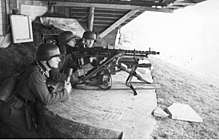
The German forces at Dieppe were on high alert, having been warned by French double agents that the British were showing interest in the area. They had also detected increased radio traffic and landing craft being concentrated in the southern British coastal ports.[14] Dieppe and the flanking cliffs were well defended; the 1,500-strong garrison from the 302nd Static Infantry Division comprised the 570th, 571st and 572nd Infantry Regiments, each of two battalions, the 302nd Artillery Regiment, the 302nd Reconnaissance Battalion, the 302nd Anti-tank Battalion, the 302nd Engineer Battalion and 302nd Signal Battalion. They were deployed along the beaches of Dieppe and the neighbouring towns, covering all the likely landing places. The city and port were protected by heavy artillery on the main approach (particularly in the myriad cliff caves) and with a reserve at the rear. The defenders were stationed in the towns and in intervening open areas and highlands that overlooked the beaches. Elements of the 571st Infantry Regiment defended the Dieppe radar station near Pourville and the artillery battery over the Scie river at Varengeville. To the east, the 570th Infantry Regiment was deployed near the artillery battery at Berneval-le-Grand.
Luftwaffe
The Luftwaffe fighter force comprised Jagdgeschwader 2 (JG2) and Jagdgeschwader 26 (JG26), with about 120 serviceable fighters, mostly Fw 190s to oppose the landings and escort around 100 serviceable bombers of Kampfgeschwader 2 and the specialist anti-shipping bombers of III./Kampfgeschwader 53 (KG 53), II./Kampfgeschwader 40 (KG 40) and I./Kampfgeschwader 77 (KG 77) mostly equipped with Dornier 217s.
Battle
On the night of 18/19 August, RAF Coastal Command carried out anti-surface vessel (ASV) patrols of the coast from Boulogne to Cherbourg; after sunrise the patrols were carried out by fighters. The Allied fleet left the south coast of England during the night, preceded by minesweepers from Newhaven clearing paths through the English Channel, followed by the flotilla of eight destroyers and accompanying Motor Gun Boats escorting the landing craft and Motor Launches. .
Initial landings
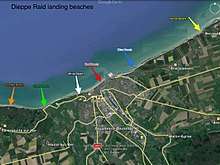
The initial landings began at 04:50 on 19 August, with attacks on the artillery batteries on the flanks of the main landing area. These were Varengeville – Sainte-Marguerite-sur-Mer (known as Orange Beach) by No. 4 Commando, Pourville (Green Beach) by the South Saskatchewan Regiment and the Queen's Own Cameron Highlanders of Canada, Puys (Blue Beach) by the Royal Regiment of Canada, and Berneval (Yellow Beach) by No. 3 Commando. On their way in, the landing craft and escorts heading towards Puys and Berneval ran into and exchanged fire with a small German convoy at 03:48.[14] The Allied destroyers HMS Brocklesby and ORP Ślązak noticed the engagement, but their commanders incorrectly assumed that the landing craft had come under fire from the shore batteries and did not come to their rescue.[2]
Yellow beach
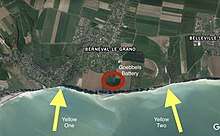
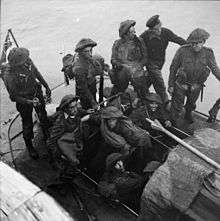
The mission for Lieutenant Colonel John Durnford-Slater and No. 3 Commando was to conduct two landings 8 mi (13 km) east of Dieppe to silence the coastal battery Goebbels near Berneval. The battery could fire upon the landing at Dieppe 4 mi (6.4 km) to the west. The three 170 mm (6.7 in) and four 105 mm (4.1 in) guns of 2/770 Batterie had to be out of action by the time the main force approached the main beach.
The craft carrying No. 3 Commando, approaching the coast to the east, were not warned of the approach of a German coastal convoy that had been located by British "Chain Home" radar stations at 21:30. German S-boats escorting a German tanker torpedoed some of the LCP landing craft and disabled the escorting Steam Gun Boat 5. Subsequently, ML 346 and Landing Craft Flak 1 combined to drive off the German boats but the group was dispersed, with some losses, and the enemy's coastal defences were alerted. The commandos from six craft who did land on Yellow I were beaten back and, unable to safely retreat or join the main force, had to surrender. Only 18 commandos got ashore on Yellow II beach. They reached the perimeter of the battery via Berneval, after it was attacked by Hurricane fighter-bombers, engaging their target with small arms fire. Although unable to destroy the guns, their sniping for a time managed to distract the battery to such good effect that the gunners fired wildly and there was no known instance of this battery sinking any of the assault convoy ships off Dieppe. The commandos were eventually forced to withdraw in the face of superior enemy forces.[14][27]
Orange beach

The mission for Lieutenant Colonel Lord Lovat and No. 4 Commando (including 50 United States Army Rangers) was to conduct two landings 6 mi (9.7 km) west of Dieppe to neutralize the coastal battery Hess at Blancmesnil-Sainte-Marguerite near Varengeville. Landing on the right flank in force at 04:50, they climbed the steep slope and attacked and neutralized their target, the artillery battery of six 150 mm guns. This was the only success of Operation Jubilee.[14] The commando then withdrew at 07:30 as planned.[10] Most of No. 4 safely returned to England. This portion of the raid was considered a model for future amphibious Royal Marine Commando assaults as part of major landing operations. Lord Lovat was awarded the Distinguished Service Order for his part in the raid and Captain Patrick Porteous No. 4 Commando, was awarded the Victoria Cross.[28][29][30][31]
Blue beach

The naval engagement between the small German convoy and the craft carrying No. 3 Commando had alerted the German defenders at Blue beach. The landing near Puys by the Royal Regiment of Canada plus three platoons from the Black Watch of Canada and an artillery detachment were tasked to neutralize machine gun and artillery batteries protecting this Dieppe beach. They were delayed by 20 minutes and the smoke screens that should have hidden their assault had already lifted. The advantages of surprise and darkness were thus lost, while the Germans had manned their defensive positions in preparation for the landings. The well-fortified German forces held the Canadian forces that did land on the beach. As soon as they reached the shore, the Canadians found themselves pinned against the seawall, unable to advance. With a bunker placed to sweep along the back of the seawall, the Royal Regiment of Canada was annihilated. Of the 556 men in the regiment, 200 were killed and 264 captured.[10]
Green Beach

On Green beach at the same time that No. 4 Commando had landed at Orange Beach, the South Saskatchewan Regiment's 1st Battalion was headed towards Pourville. They beached at 04:52, without having been detected. The battalion managed to leave their landing craft before the Germans could open fire. However, on the way in, some of the landing craft had drifted off course and most of the battalion found themselves west of the River Scie rather than east of it. Because they had been landed in the wrong place, the battalion, whose objective was the hills east of the village and the Hindenburg Battery artillery, had to enter Pourville to cross the river by the only bridge.[10] Before the Saskatchewans managed to reach the bridge, the Germans had positioned machine guns and anti-tank guns there which stopped their advance. With the battalion's dead and wounded piling up on the bridge, Lieutenant Colonel Charles Cecil Ingersoll Merritt, the commanding officer, attempted to give the attack impetus by repeatedly and openly crossing the bridge, in order to demonstrate that it was feasible to do so.[32] However, despite the assault resuming, the South Saskatchewans and the Queen's Own Cameron Highlanders of Canada, who had landed beside them, were unable to reach their target.[10] While the Camerons did manage to penetrate further inland than any other troops that day, they were also soon forced back as German reinforcements rushed to the scene.[14] Both battalions suffered more losses as they withdrew; only 341 men were able to reach the landing craft and embark, and the rest were left to surrender. For his part in the battle, Lieutenant Colonel Merritt was awarded the Victoria Cross.[29]
Pourville radar station
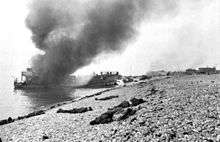
One of the objectives of the Dieppe Raid was to discover the importance and performance of a German radar station on the cliff-top to the east of the town of Pourville. To achieve this, RAF Flight Sergeant Jack Nissenthall, a radar specialist, was attached to the South Saskatchewan Regiment landing at Green Beach. He was to attempt to enter the radar station and learn its secrets, accompanied by a small unit of 11 men of the Saskatchewans as bodyguards. Nissenthall volunteered for the mission fully aware that, due to the highly sensitive nature of his knowledge of Allied radar technology, his Saskatchewan bodyguard unit was under orders to kill him to prevent him from being captured. He also carried a cyanide pill as a last resort.[33]
After the war, Lord Mountbatten claimed to author James Leasor, when being interviewed during research for the book Green Beach, that "If I had been aware of the orders given to the escort to shoot him rather than let him be captured, I would have cancelled them immediately". Nissenthall and his bodyguards failed to overcome the radar station defences but Nissenthall was able to crawl up to the rear of the station under enemy fire and cut all telephone wires leading to it. The operators inside resorted to radio to talk to their commanders which was intercepted by listening posts on the south coast of England. The Allies were able to learn a great deal about the location and density of German radar stations along the Channel coast which helped to convince Allied commanders of the importance of developing radar jamming technology. Only Nissenthall and one South Saskatchewan of the party returned to England.[34][35]
Main Canadian landings
Red and White Beaches
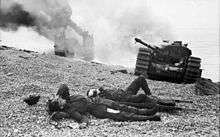
Preparing the ground for the main landings, four destroyers were bombarding the coast as landing craft approached. At 05:15, they were joined by five RAF Hurricane squadrons who bombed the coastal defences and set a smokescreen to protect the assault troops. Between 03:30, and 03:40, 30 minutes after the initial landings, the main frontal assault by the Essex Scottish and the Royal Hamilton Light Infantry started. Their infantry was meant to be supported by Churchill tanks of the 14th Army Tank Regiment landing at the same time, but the tanks arrived on the beach late. As a result, the two infantry battalions had to attack without armour support. They were met with heavy machine-gun fire from emplacements dug into the overlooking cliffs. Unable to clear the obstacles and scale the seawall, they suffered heavy losses.[14] Captain Denis Whitaker of the Royal Hamilton Light Infantry recalled a scene of absolute carnage and confusion, with soldiers being cut down by German fire all along the sea wall while his commanding officer, Colonel Bob Labatt, desperately tried to use a broken radio to contact General Roberts while ignoring his men.[36] When the tanks eventually arrived only 29 were landed. Two of those sank in deep water, and 12 more became bogged down in the soft shingle beach. Only 15 of the tanks made it up to and across the seawall. Once they crossed the seawall, they were confronted by a series of tank obstacles that prevented their entry into the town. Blocked from going further, they were forced to return to the beach where they provided fire support for the now retreating infantry. None of the tanks managed to return to England. All the crews that landed were either killed or captured.[10]
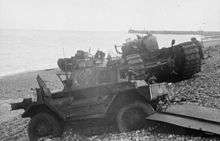
Unaware of the situation on the beaches because of a smoke screen laid by the supporting destroyers, Major General Roberts sent in the two reserve units: the Fusiliers Mont-Royal and the Royal Marines. At 07:00, the Fusiliers under the command of Lieutenant Colonel Dollard Ménard in 26 landing craft sailed towards their beach. They were heavily engaged by the Germans, who hit them with heavy machine gun, mortar and grenade fire, and destroyed them; only a few men managed to reach the town.[10] Those men were then sent in towards the centre of Dieppe and became pinned down under the cliffs and Roberts ordered the Royal Marines to land in order to support them. Not being prepared to support the Fusiliers, the Royal Marines had to transfer from their gunboats and motorboat transports onto landing craft. The Royal Marine landing craft were heavily engaged on their way in with many destroyed or disabled. Those Royal Marines that did reach the shore were either killed or captured. As he became aware of the situation the Royal Marine commanding officer Lieutenant Colonel Phillipps, stood upon the stern of his landing craft and signalled for the rest of his men to turn back. He was killed a few moments later.[14]
During the raid, a mortar platoon from the Calgary Highlanders, commanded by Lieutenant F. J. Reynolds, was attached to the landing force but stayed offshore after the tanks on board (code-named Bert and Bill) landed. [37] Sergeants Lyster and Pittaway were Mentioned in Despatches for their part in shooting down two German aircraft and one officer of the battalion was killed while ashore with a brigade headquarters. [38] [39]
At 09:40, under heavy fire, the withdrawal from the main landing beaches began and was completed by 14:00.[14]
Air operations
At 04:16 six Bostons attacked German coastal artillery in the twilight which led to the results not being observed. Soon afterwards 14 Bostons flew to Dieppe to drop smoke bombs around the German guns on the eastern heights, bombing the Bismarck batteries between 05:09 and 05:44 with a hundred and fifty 100 lb (45 kg) smoke bombs at 50–70 ft (15–21 m), flying through a storm of anti-aircraft fire. A smoke screen 800–1,000 yd (730–910 m) drifted 4–5 mi (6.4–8.0 km) seawards, thickened by the smoke of a burning field of wheat. Six Bristol Blenheim bombers from 13 Squadron and one from 614 Squadron dropped 100 lb (45 kg) phosphorus bombs south of German FlaK sites. Nine of the twelve Bostons were damaged, two crashed on landing and one Blenheim smoke layer from 614 Squadron was damaged and the pilot wounded, the aircraft crashing on landing and bursting into flames.[40]
Just before 08:00 two squadrons of cannon-armed Hurricanes were ordered to attack E-boats coming from Boulogne; they were accompanied by two fighter cover squadrons.[41]
The airfield at Abbeville-Drucat was attacked by 24 Boeing B-17 Flying Fortresses, escorted by four squadrons of USAAF Spitfire IXs at 10:30[42] putting it out of action for "two vital hours".[43] After the attack, a wing of Typhoons made a feint towards Ostend[42] The Mustangs reconnoitred outside the main area looking for reinforcements on the roads to Dieppe and from Amiens, Rouen, Yvetot and Le Havre. Flying from RAF Gatwick, they contacted the HQ ship then, having flown a sortie, passed information to the HQ ship before returning to Gatwick and phoning report to the air commander. Reconnaissance sorties were stopped after 12:00[42] Although taken by surprise, the German fighters soon began to attack the air umbrella. The RAF was moderately successful in protecting the ground and sea forces from aerial bombing but were hampered by operating far from their home bases. Spitfires were at the limit of their range, with some only being able to spend five minutes over the combat area.[44]
As more German aircraft appeared, the number of British aircraft over Dieppe was increased from three to six squadrons and at times up to nine squadrons were present.[45]
Six squadrons (four British, two Canadian) flew the Spitfire Mk IX, the only British fighter equal to the Fw 190, on its operational debut at Dieppe.[46] During the battle, Fighter Command flew 2,500 sorties over Dieppe and achieved a narrow victory over the Luftwaffe.[46] The plan to centralise information gleaned from German radar, W/T and R/T and other transmissions failed because the Luftwaffe operation against the landing overwhelmed the reporting system and the war room at 11 Group HQ was overwhelmed with reports as the Luftwaffe reaction increased. RAF Kingsdown was not informed about developments and failed to identify German fighter reinforcements arriving from all over France and the Low Countries. The new 6IS Fish party, to decrypt high-speed non-Morse transmissions via the German Geheimschreiber, had no time to prepare and missed important information.[47] Despite the failures of control and intelligence, the air umbrella prevented the Luftwaffe from making many attacks on the landing or the evacuation of the Allied force.[46][43]
Aftermath
Analyses
German
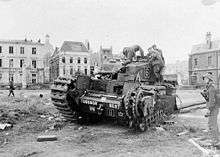
The capture of a copy of the Dieppe plan allowed the Germans to analyse the operation. Senior German officers were unimpressed; General Konrad Haase considered it "incomprehensible" that a division was expected to overrun a German regiment that was supported by artillery. "...the strength of naval and air forces was entirely insufficient to suppress the defenders during the landings". General Adolf-Friedrich Kuntzen believed it "inconceivable" that the Pourville landings were not reinforced with tanks.[48] The Germans were unimpressed by the Churchill tanks left behind; one report concluded "in its present form the Churchill is easy to fight". Its gun was described as "poor and obsolete" and the armour was compared unfavourably with that used in German and Soviet tanks.[49] The Germans recognized that the Allies were certain to learn some lessons from the operation, with General Gerd von Rundstedt observing that, "Just as we are going to evaluate these experiences for the future so is the assaulting force ... perhaps even more so as it has gained the experience dearly. He will not do it like this a second time!".[50]
Allied
Dieppe became a textbook example of "what not to do" in amphibious operations and laid the framework for the Normandy landings two years later. Dieppe showed the need for
- preliminary artillery support, including aerial bombardment[14]
- surprise
- proper intelligence concerning enemy fortifications
- avoidance of a frontal attack on a defended port
- proper re-embarkation craft.[51]
While the Canadian contingent fought bravely in the face of a determined enemy, it was ultimately circumstances outside their control which sealed their fate.[51] Despite criticism concerning the inexperience of the Canadian brigades, scholars have noted that even seasoned professionals would have been hard-pressed under the deplorable conditions brought about by their superiors. The commanders who planned the raid on Dieppe had not envisaged such losses.[51] This was one of the first attempts by the Western Allies on a German-held port city. As a consequence, planning from the highest ranks in preparation for the raid was minimal. Basic strategic and tactical errors were made which resulted in scores of Allied (particularly Canadian) deaths.
The British developed specialist armoured vehicles for engineers to perform tasks protected by armour.
While the RAF were able to keep German aircraft from the land battle and the ships, the operation showed "major deficiencies in RAF ground support techniques" and this led to the creation of an integrated tactical air force for army support.[52] Because the tracks of most of the Churchill tanks were caught up in the shingle beach, the Allies began to study beach geology where they intended to land and adapting vehicles for them.[53] The Allies changed their view that capturing a big port was necessary to establish a second front. The damage inflicted on a port to capture it, would make it useless afterwards. Prefabricated Mulberry harbours were to be built and towed to beaches during the invasion.[54]
Casualties


Of the nearly 5,000-strong Canadian contingent, 3,367 were killed, wounded or taken prisoner, an exceptional casualty rate of 68 percent.[55] The 1,000 British Commandos lost 247 men. The Royal Navy lost the destroyer Berkeley (on the return crossing, it was hit by bombs from a Fw 190 and then scuttled by Albrighton) and 33 landing craft, suffering 550 dead and wounded. The RAF lost 106 aircraft. RAF Air Sea Rescue Services picked up around 20 pilots at the loss of three of Dover's five High Speed Launches.[56] Among the RAF losses, six RAF aircraft had been shot down by gunners on their own side, one Typhoon was shot down by a Spitfire and two others were lost when their tails broke off (a structural issue with early Typhoons), and two Spitfires collided during the withdrawal across the Channel.[57]
The Germans suffered 591 casualties, 322 fatal and 280 wounded, 48 aircraft and one patrol boat.[58] Of the 50 US Army Rangers serving in Commando units, six were killed, seven wounded and four captured.
The losses at Dieppe were claimed to be a necessary evil.[51] Mountbatten later justified the raid by arguing that lessons learned at Dieppe in 1942 were put to good use later in the war. He later claimed, "I have no doubt that the Battle of Normandy was won on the beaches of Dieppe. For every man who died in Dieppe, at least 10 more must have been spared in Normandy in 1944." In direct response to the raid on Dieppe, Churchill remarked that "My Impression of 'Jubilee' is that the results fully justified the heavy cost" and that it "was a Canadian contribution of the greatest significance to final victory."[59]
To others, especially Canadians, it was a major disaster. The exception was the success gained by the battle-hardened British commandos against the coast artillery batteries near Varengeville and Berneval. Of the nearly 5,000 Canadian soldiers, more than 900 were killed (about 18 per cent) and 1,874 taken prisoner (37%).[5][60]
German propaganda
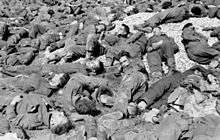
Dieppe was a German propaganda coup in which the Dieppe raid was described as a military joke, noting the amount of time needed to plan such an attack, combined with the losses suffered by the Allies, pointed only to incompetence.[61] The propaganda value of German news on the raid was enhanced by British foot dragging, Allied media being forced to carry announcements from German sources.[62] These attempts were made to rally the morale of the German people despite the growing intensity of the Allied strategic bombing campaign on German cities, and large daily casualties on the Eastern Front.[61] Marshal Philippe Pétain of France wrote a letter of congratulation to the German Army for "cleansing French soil of the invader" of this "most recent British aggression". Pétain suggested that French troops be allowed to serve with German coastal garrisons, a suggestion that was not viewed with enthusiasm by the German Army and nothing came of it. The letter was given much publicity in Germany and France as a sign of how the French people allegedly appreciated Germany's efforts to defend them from les Anglo-Saxons. Pétain's letter was later used as an exhibit for the prosecution at his trial for high treason in 1945.[63]
The air battle
Fighter Command claimed to have inflicted many losses on the Luftwaffe for an RAF loss of 106 aircraft, 88 fighters (including 44 Spitfires), 10 reconnaissance aircraft and eight bombers; 14 other RAF aircraft were struck off charge from other causes such as accidents.[64] Other sources suggest that up to 28 bombers were lost and that the figure for destroyed and damaged Spitfires was 70.[65] The Luftwaffe suffered 48 aircraft losses, 28 bombers, half of them Dornier Do 217s from KG 2; JG 2 lost 14 Fw 190s and eight pilots killed, JG 26 lost six Fw 190s with their pilots.[66] The RAF lost 91 aircraft shot down and 64 pilots; 47 killed and 17 taken prisoner, the RCAF lost 14 aircraft and nine pilots and 2 Group lost six bombers.[46][lower-alpha 5] Leigh-Mallory considered the losses "remarkably light in view of the number of Squadrons taking part and the intensity of the fighting" noting that the tactical reconnaissance suffered heaviest with about two casualties per squadron.[68] The Luftwaffe in France was back to full strength within days of the raid. Copp wrote that Dieppe failed to inflict the knockout blow against the Luftwaffe that the RAF sought. Though the Allies continued to lose on average two aircraft for every one German aircraft destroyed for the rest of 1942, the output of fighters by the United States, Britain and Canada combined with better Allied pilot training led to the Luftwaffe gradually losing the war of attrition in the skies above France. Copp concluded that: "The battle for air superiority was won [on] many fronts by continuous effort and August 19, 1942 was part of that achievement".[46] The Forward Air Controller, Air Commodore Adrian Cole, was injured when Calpe was attacked and was awarded the DSO for gallantry.[69]
Prisoners of war
Brigadier William Southam brought ashore his copy of the assault plan, classified as a secret document. Southam tried to bury it under the pebbles at the time of his surrender but was spotted and the plan retrieved by the Germans. The plan, later criticized for its size and needless complexity, contained orders to shackle prisoners.[70] The British Special Service Brigade tied the hands of prisoners taken on raids and the practice had been ordered for the Dieppe Raid "to prevent destruction of their documents". Roberts objected to this with the chief of combined operations. After capturing the orders for Operation Jubilee, the Germans threatened on 2 September to shackle the prisoners taken at Dieppe. The War Office announced that if an order existed it would be rescinded and the Germans withdrew the threat on 3 September. On 7 October the Germans revived the controversy after more information emerged about the Dieppe operation and that German prisoners taken during the small 4 Octobera raid on Sark on were alleged to have been tied. On 8 October British and Canadian prisoners were tied in reprisal, which led to counter reprisals.[71] Supposed Anglo-Canadian atrocities committed against German POWs at Dieppe was one of the excuses Hitler gave for the Commando Order of October 1942 for all Allied commando prisoners to be executed. Hitler decided to reward the town for not helping in the raid by freeing French POWs from Dieppe and Berlin radio announced the release of 750 "sons of Dieppe" imprisoned since 1940.[63] For the town residents' "perfect discipline and calm", although the residents had not had much time to furnish the invaders with an instant Fifth Column, Hitler gave the town a gift of Fr 10 million, to repair the damage caused during the raid.[72]
German preparedness
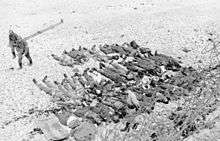
The fiasco has led to a discussion of whether the Germans knew of the raid in advance. Security in the area from which the operation was launched was poor and 'a good deal could be deduced simply by shrewd observation and careful attention to careless talk'.[73] Since June 1942, the BBC had been broadcasting warnings to French civilians of a "likely" action, urging them to quickly evacuate the Atlantic coastal districts.[74][75][76] Indeed, on the day of the raid itself, the BBC announced it, albeit at 08:00, after the landings had taken place.[77]
First-hand accounts and memoirs of many Canadian veterans who documented their experiences on the shores of Dieppe remark about the preparedness of the German defences as if they were warned, on touching down on the Dieppe shore, the landing ships were immediately shelled with the utmost precision as troops disembarked. The volume and tone of these accounts meant that a Canadian government report at the end of 1942, concluded that "They seem to have had ample warning of the raid and to have made thorough preparations for dealing with it".[78] Commanding officer Lt Colonel Labatt testified to having seen markers on the beach used for mortar practice, which appeared to have been recently placed.[79]
The belief that the Germans were forewarned has been strengthened by accounts of German and Allied POWs. Major C. E. Page, while interrogating a German soldier, found out that four machine-gun battalions were brought in "specifically" in anticipation of a raid. There are numerous accounts of interrogated German prisoners, German captors and French citizens who all conveyed to Canadians that the Germans had been preparing for the landing for weeks.[80][81] While it is likely that the Germans were expecting an attack somewhere on the French shoreline, evidence of expectation of an attack at Dieppe is less conclusive. Proponents of this view point out that elements of the Canadian forces, such as at Green beach, landed without trouble. Merrit said "How could the Germans have known if we got in on our beach against defences which were unmanned?".[82] No 4 Commando also reported that they achieved surprise against the gun batteries they were to destroy.[83] Statements by German POWs that the raid was fully expected are explained as being propaganda.[84]
Daily Telegraph crossword controversy
On 17 August 1942, the clue "French port (6)" appeared in the Daily Telegraph crossword (compiled by Leonard Dawe), followed by the solution, "Dieppe"; the raid on Dieppe took place the next day, on 19 August.[74] The War Office suspected that the crossword had been used to pass intelligence to the Germans and called upon Lord Tweedsmuir, a senior intelligence officer attached to the Canadian Army, to investigate. Tweedsmuir later said, "We noticed that the crossword contained the word 'Dieppe', and there was an immediate and exhaustive inquiry which also involved MI5. But in the end, it was concluded that it was just a remarkable coincidence—a complete fluke".[85] A similar crossword coincidence occurred in May 1944, prior to D-Day. Multiple terms associated with Operation Overlord (including the word "Overlord") appeared in the Daily Telegraph crossword (also written by Dawe) and after another investigation by MI5 which concluded that it was another coincidence. Further to this, a former student identified that Dawe frequently requested words from his students, many of whom were children in the same area as US military personnel.[86]
The Enigma pinch
Research undertaken over a 15-year period by military historian David O'Keefe uncovered 100,000 pages of classified British military archival files that documented a "pinch" mission overseen by Ian Fleming (best known later as author of the James Bond novels), coinciding with the Dieppe Raid. O'Keefe states that No. 30 Commando was sent to Dieppe to steal one of the new German 4-rotor Enigma code machines, plus associated codebooks and rotor setting sheets. The Naval Intelligence Division (NID) planned the "pinch" to pass such items to cryptanalysts at Bletchley Park to assist with Ultra decryption operations.[3] O'Keefe alleges the presence of other troops landing at Dieppe was to provide support and create a distraction for the commando units attempting to reach the German admiralty headquarters and capture the Enigma machine, that the premise of the Dieppe Raid was 'cover' for the Enigma target.
No 30 Commando was not formed until a month after the raid and indications of involvement may be erroneous.[4]
An article that ran in Britain at War Magazine in August 2017 provided an alternative view. In that issue, Professor of Naval History, Eric Grove, explained that the 'Enigma Pinch' is "more a reflection of the contemporary fascination with secret intelligence rather than the reality of 1942."[87] Obtaining useful intelligence was among the objectives - including the capture of a four-rotor Enigma cipher machine but it was one of many objectives. Grove concludes that the Dieppe Raid was not, as claimed, cover for a ‘snatch’ and also recognizes that the decision to form the Intelligence Assault Units to gather intelligence material was not made until after Operation Jubilee had been ordered.[87]
Commemoration
| Location | Date | Description | Manufacturer | Inscription | Window |
|---|---|---|---|---|---|
| Sir Arthur Currie Hall, Royal Military College of Canada, Kingston, Ontario | 1968 | 1 light Dieppe Dawn | Robert McCausland Limited | * In memory of Dieppe Dawn 19 August 1942 by classes of 1948–52 |
Dieppe War Cemetery
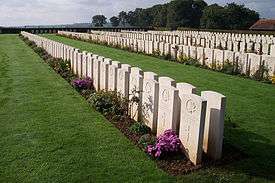
Allied dead were initially buried in a mass grave but the bodies were reburied at Vertus Wood on the edge of the town.[88] The Dieppe Canadian War Cemetery headstones have been placed back-to-back in double rows, the norm for a German war cemetery but unusual for Commonwealth War Graves Commission sites. When the Allies liberated Dieppe as part of Operation Fusilade in 1944, the grave markers were replaced but the layout was left unchanged to avoid disturbing the remains.
Honours and awards
Three Victoria Crosses were awarded for the operation: one to Captain Patrick Porteous, Royal Regiment of Artillery attached to No. 4 Commando, in the British forces; and two to Canadians – the Reverend John Weir Foote, padre to the Royal Hamilton Light Infantry and Lieutenant Colonel Charles Merritt of the South Saskatchewan Regiment.
Porteous was severely wounded in the battle but was evacuated at the end of the battle; both Foote and Merritt were captured and became prisoners of war, although in the instance of Foote, he deliberately abandoned his landing craft and chose to be captured so that he could minister to his fellow Canadians who were now POWs.[89]
Marcel Lambert of the 14th Army Tank Regiment (The Calgary Regiment (Tank)), fought aggressively in the battle and was captured. He, along with all the participants in the raid, was awarded a "certificate" from the Government of France. In the 1980s the Government of Canada issued to all raid veterans a "volunteer service medal."[90]
Despite the failure of the operation, Major General Roberts was awarded the Distinguished Service Order. Among the enlisted personnel, Private William A. Haggard[91] of the South Saskatchewan Regiment was awarded the Distinguished Conduct Medal, and subsequently, field promoted to lieutenant, for his actions during the raid.
A Canadian signalman, Sergeant David Lloyd Hart, was awarded the Military Medal for his efforts during the raid. Hart maintained what became the sole line of radio communications between the men ashore and the commanders out at sea. He is credited with saving the lives of 100 men through his signals work, being able to order their retreat. Hart later became the longest-serving officer in the Canadian Armed Forces, serving in active and honorary roles for 81 years. He died in March 2019, aged 101.[92][93]
See also
- Beach Comber, a famous war pigeon that was highly decorated for his role in the Dieppe Raid.
- Operation Jubilee order of battle for all units involved.
- Dieppe, a Canadian television miniseries that dramatized the events leading up to Operation Jubilee.
References
Notes
- Only air and naval forces; Polish forces included the No. 302, 303, 306, 308 and No. 317 Fighter Squadrons of the Polish Air Forces fighting alongside the RAF,[1] as well as the ORP Ślązak destroyer[2]
- Only air forces. The Czechoslovak forces included the No. 310 and No. 312 Fighter Squadrons of the RAF
- O'Keefe alternately states they were sent in as part of 40 Commando[3] but 30 Commando/30AU was not formed until a month later and indications that it was involved may be erroneous[4]
- The Hurricanes were a mix of "Cannon-armed" Hurricane IIC and bomb carrying Hurricanes
- Leigh-Mallory reported losses of 70 pilots and 10 crew killed or missing; aircraft destroyed as 88 fighters, 10 Army Cooperation aircraft, one from 2 Group and seven of the smoke laying aircraft.[67]
Citations
- Król 1990, pp. 95–96, 250.
- Ford 2004, p. 41.
- Ogrodnik, Irene. "Breaking German codes real reason for 1942 Dieppe raid: historian." Archived October 24, 2012, at the Wayback Machine Global News, 9 August 2012. Retrieved: 13 August 2012.
- "History of 30 Assault Unit 1942–1946". Liddell Hart Centre for Military Archives, King's College London. Retrieved 2 June 2010.
- Herd, Alex. "Dieppe Raide.'Canadian Encyclopedia. Retrieved: 23 March 2016.
- Defelice, James. "First Blood for the Army Rangers at Dieppe.'HISTORYNET. Retrieved: 26 July 2019.
- Buckingham 2004, p. 15.
- Copp, Terry. "The Air over Dieppe." Legion, June 1996, p. 6.
- Copp, Terry. "The Air over Dieppe." Legion, June 1996, p. 7.
- "Dieppe raid." Juno Beach Centre. Retrieved: 23 March 2016.
- Whitaker 1992, p. 29.
- Churchill 1950, pp. 509–10.
- Christie 2000, pp. 6–7.
- Thompson, Julian. "The Dieppe Raid." BBC (World Wars in Depth series), 6 June 2010.
- "Operation Jubilee." Combined Operations, 7 June 2010.
- Henry 1993, p. 6.
- Atkin 1980, p. 24.
- Copp 2004, p. 34.
- Greenhous 1994, pp. 232–233.
- Richards & Saunders 1975, pp. 143–144.
- Leigh-Mallory p61
- Macksey 2004, p. 151.
- Leigh-Mallory p61
- Leigh-Mallory "After Action Report", para 7, 69
- Bowyer 1979, pp. 248–249.
- Atkin 1980, p. 23.
- Dieppe – Operation Jubilee Warfare Magazine
- "No. 35729". The London Gazette (Supplement). 2 October 1942. p. 4328.
- "No. 35729". The London Gazette (Supplement). 2 October 1942. pp. 4323–24.
- "No. 35730". The London Gazette (Supplement). 2 October 1942. p. 4339.
- Dunning 2003, pp. 65–87.
- Atkin 1980, p. 141.
- Atkin 1980, p. 136.
- Leasor, James. Green Beach. London: William Heinemann Ltd., 2011. ISBN 978-1-908291-10-3.
- Goldstein, Ron. "Jack Nissenthall: The VC Hero Who Never Was (Part 1a)." BBC (WW2 People's War), 2004. Retrieved: 30 April 2009.
- Kelly, Arthur. "A battle doomed to fail for all the wrong reasons."The National Post, 17 August 2012. Retrieved: 5 January 2016.
- "Mortar platoon." Archived December 15, 2005, at the Wayback Machine calgaryhighlanders.com. Retrieved: 8 April 2010.
- "Lyster and Pittaway." Archived 2010-12-31 at the Wayback Machine Harry Palmer Gallery. Retrieved: 8 April 2010.
- "Casualty Details: Insinger, Theodor Marie". Commonwealth War Graves Commission.
- Bowyer 1979, pp. 249–250.
- Leigh-Mallory, After Action Report, p. 65
- Leigh-Mallory, Trafford (2003), "Air Operations at Dieppe: An After-Action Report", Canadian Military History, XII (4), Article 6,
Report by the Air Force Commander on the Combined Operation Against Dieppe - August 19th, 1942, 5 September 1942
- Richards & Saunders 1975, p. 144.
- Atkin p. 199
- Leigh-Mallory, After Action Report, p67
- Copp, Terry. "The Air over Dieppe." Legion, June 1996, p. 8.
- Macksey 2004, pp. 151, 68.
- Atkin 1980, p. 261.
- Atkin 1980, p. 262.
- Atkin 1980, p. 263.
- Maguire 1963, p. 190.
- "RAF History Timeline 1942." Archived 2010-12-06 at the Wayback Machine raf.mod.uk, 2012 [last update]. Retrieved: 21 July 2012.
- Foot, M.R.D. "The Dieppe raid."History Today, August 1992. Retrieved: 29 November 2015.
- Atkin 1980, p. 274
- Robertson 1962, p. 386.
- Leigh Mallory, After Action Report, p57
- Schoeman, Michael (December 1969), "Air Umbrella - Dieppe", Military History Journal, The South African Military History Society, I (No 5)
- Rahn 2001, p. 441.
- Maguire 1963, p. 181.
- Grimsley, Mark. "What If the Dieppe Raid Had Succeeded? Historynet.com, 2 June 2011. Retrieved: 19 August 2013.
- Hall, David. "The German View of the Dieppe Raid." Military History Lecture, Laurier Centre for Military Strategic and Disarmament Studies, Wilfrid Laurier University, Waterloo, 13 October 2011.
- Atkin 1980, p. 257.
- Smith 2010, p. 338.
- Atkin 1980, p. 208.
- Franks 1998, pp. 56–62.
- Weal 1996, p. 26.
- Leigh-Mallory Appendix C
- Leigh-Mallory "Covering Letter by Air Force Commander", After Action Report, p2
- "No. 35729". The London Gazette (Supplement). 2 October 1942. p. 4331.
- "Bowmanville, 1942: The 'Shackling Crisis' and the Treatment of German Prisoners of War in Canada". Online Atlas on the History of Humanitarianism and Human Rights. IEG. Retrieved 7 June 2019.
- Stacey 1956, pp. 396–297.
- Atkin 1980, p. 264.
- Campbell 1993, pp. 4–5.
- Fleming, Vic. "Mystery of the D-day crosswords, Part 1." Archived January 19, 2012, at the Wayback Machine Daily Record (Little Rock), 2008. Retrieved: 7 June 2010.
- "Warning by radio: Notice of 'likely' war moves given civilians in Nazi-held zone." The New York Times, 9 June 1942, p. 1. Retrieved: 20 August 2012.
- Beattie, Edward W. "Big Commando Attack Due, England Hints." Pittsburgh Press 8 June 1942. Retrieved: 9 September 2010.
- Campbell 1993, p. 4.
- Atkin 1980, p. 266.
- Stacey 1944, paragraph 43.
- Poolton and Poolton-Turney 1998, p. 46.
- Whitaker 1992, p. xv.
- Atkin 1980, p. 267.
- Atkin 1980, p. 100.
- Campbell 1993, p. 13.
- Gilbert 2008, pp. 19–20.
- Wallington, Richard S. J. "The Crossword Panic of 1944." Historic UK. Retrieved: 21 July 2012.
- Britain at War Magazine, August 2017, Section 'The Dieppe Raid, 75th Anniversary (Article: Dieppe - The Reason Why; Box Panel, The Enigma Factor) p.66
- Atkin 1980, p. 265.
- "The 1942 Dieppe Raid". Veterans Affairs Canada. Retrieved 4 March 2020.
- Twice-told Tales of St. Albert's Past, p. 97
- Lawren P. Harris (1942). "Portrait of Private W. A. Haggard". Canadian War Museum. Retrieved 4 January 2019.
- Lowrie, Morgan (April 1, 2019). "Dieppe veteran and the Canadian Army's longest-serving officer David Lloyd Hart was 'a friend and mentor to many'". The Globe and Mail. Montreal, ON Canada.
- "WWII vet, Dieppe hero David Hart dies at age 101" (Video). CBC News. Toronto, ON Canada. April 1, 2019.
Bibliography
- Atkin, Ronald. Dieppe 1942: The Jubilee Disaster. London: Book Club Associates, 1980. ISBN 978-0-333-19187-3.
- Boog, H.; Rahn, W.; Stumpf, R.; Wegner, B. (2001) [1990]. Der globale Krieg: Die Ausweitung zum Weltkrieg und der Wechsel zur Initiative 1941 bis 1943 [Widening of the Conflict into a World War and the Shift of the Initiative 1941–1943]. Das Deutsche Reich und der Zweite Weltkrieg (Germany and the Second World War). VI. Translated by Osers, Ewald; Brownjohn, John; Crampton, Patricia; Willmot, Louise (eng. trans. Cambridge University Press, London ed.). Stuttgart: Deutsche Verlags-Anstalt for the Militärgeschichtlichen Forschungsamt. pp. 439–442. ISBN 0-19-822888-0.
- Rahn, W. "Chapter III: The Conduct of the War in the Atlantic and the Coastal Area (3.) Mine Warfare and Coastal Operations". In Boog et al. (2001).
- Bowyer, M. J. F. (1979) [1974]. 2 Group RAF: A Complete History 1936–1945 (2nd Faber Paperbacks ed.). London: Faber and Faber. ISBN 0-571-11460-1.
- Buckingham, William. D-Day: The First 72 hours. Stroud, Gloucestershire, UK: Tempus Publishing. 2004. ISBN 0-7524-2842-X.
- Campbell, J. P. Dieppe Revisited: A Documentary Investigation. London: Cass, 1993. ISBN 0-7146-3496-4.
- Christie, N. M. (2000). The Suicide Raid: The Canadians at Dieppe August 19th, 1942. Access to History (No. 5). Ottawa: CEF Books. ISBN 1-896979-36-X.
- Churchill, Sir Winston. The Second World War: The Hinge of Fate. Cambridge, Massachusetts: Houghton Mifflin, 1950.
- Copp, Terry A Nation at War, 1939–1945. Waterloo, Ontario: Wilfrid Laurier Press, 2004. ISBN 978-0-96887-505-6.
- Copp, Terry and Mike Bechthold. The Canadian Battlefields in Northern France: Dieppe and the Channel Ports. Waterloo: WLU Press, 2011. ISBN 1-926804-01-5
- Dumais, Lucien A. Un Canadien français à Dieppe. Paris: Éditions France-Empire, 1968.
- Dunning, James. The Fighting Fourth. Stroud Sutton, 2003. ISBN 0-7509-3095-0.
- Ford, Ken. Dieppe 1942: Prelude to D-Day Campaign 127 Oxford: Osprey, 2004 .
- Fowler, Will. Allies at Dieppe. Oxford: Osprey, 2012. ISBN 978-1-78096-596-3.
- Franks, Norman L. R. (1998). Royal Air Force Losses of the Second World War: Operational Losses: Aircraft and Crews 1942–1943. II. London: Midland. ISBN 1-85780-075-3.
- Gilbert, Val. A Display of Lights (9): The Lives and Puzzles of the Telegraph's Six Greatest Cryptic Crossword Setters. London: Macmillan (Telegraph Group Limited), 2008. ISBN 978-0-230-71446-5.
- Greenhous, B.; et al. (1994). The Official History of the Royal Canadian Air Force: The Crucible of War, 1939–1945. III. Toronto: University of Toronto Press and Department of National Defence. ISBN 978-0-8020-0574-8. D2-63/3-1994E.
- Griffins, Richard. Marshal Pétain. London: Constable, 1970. ISBN 0-09-455740-3
- Hamilton, Nigel. Monty: The Making of a General. London: Hamish Hamilton Ltd., 1981.ISBN 0-241-10583-8.
- Henry, Hugh G. Dieppe Through the Lens of the German War photographer. London: After the Battle, 1993. ISBN 0-900913-76-2. A Canadian historian covers the actions of each one of the 29 tanks disembarked on the raid with photos, oral history and primary sources. The author later did his doctoral dissertation on the raid.
- Hughes-Wilson, John. Military Intelligence Blunders and Cover-ups. Bath: Robinson. 2004. ISBN 978-1-84119-871-2.
- Król, Wacław. Zarys działań polskiego lotnictwa w Wielkiej Brytanii 1940–1945 (History of the Polish Air Forces in Great Britain 1940–1945). Warsaw: Wydawnictwa Komunikacji i Łączności, 1990. ISBN 978-83-206-0852-6.
- Leasor, James. Green Beach. London: House of Stratus, 2011, First edition 2008. ISBN 978-1-908291-10-3.
- Macksey, K. (2004) [2003]. The Searchers: Radio Intercept in Two World Wars (2nd ed.). London: Cassell Military Paperbacks. ISBN 0-304-36651-X.
- Maguire, Eric. "Evaluation." Dieppe, August 19. London: J. Cape, 1963.
- O'Keefe, David. "One Day In August : The Untold Story Behind Canada's Tragedy At Dieppe", Alfred A Knopf Canada, 2013, ISBN 978-0-345-80769-4.
- Poolton, Jack with Jayne Poolton-Turney. Destined to Survive: A Dieppe Veteran's Story. Toronto: Dundurn Press 1998. ISBN 1-55002-311-X.
- Robertson, Terence. Dieppe: The Shame and the Glory. Boston: Little, Brown, 1st U.S. edition, 1962.
- Smith, C. (2010) [2009]. England's Last War against France: Fighting Vichy 1940–1942 (2nd pbk. Phoenix (Orion) ed.). London: Weidenfeld & Nicolson. ISBN 978-0-7538-2705-5.
- Stacey, Colonel C.P. "The Lessons of Dieppe." Report No. 128: The Lessons of Dieppe and their Influence on the Operation Overlord. Ottawa, Canada: Department of National Defence Canadian Forces, 1944.
- Stacey, C. P. (1956) [1955]. "Chapter X: Tasks and Operations 1941–1942; Chapter XI: The Raid on Dieppe 19 August 1942; Chapter XII: Dieppe: Losses, Comments and Aftermath". Six Years of War: The Army in Canada, Britain and the Pacific. Official History of the Canadian Army in the Second World War. I (2nd corr. online scan ed.). Ottawa: Queen's Printer and Controller of Stationery by Authority of the Minister of National Defence. pp. 323–408. OCLC 1113687432. Retrieved 19 Jun 2020 – via Government of Canada: Directorate of History and Heritage.
- Taylor, A.J.P. The Second World War: An Illustrated History. London: Penguin Books, 1976. ISBN 0-14-004135-4.
- Thompson, H. L. (1956). "Chapter 16 Day Fighters During 1942". New Zealanders with the Royal Air Force. The Official History of New Zealand in the Second World War 1939–1945. II (online scan ed.). Wellington, New Zealand: Historical Publications Branch. pp. 333–358. OCLC 846897274. Retrieved 19 June 2020 – via New Zealand Electronic Text Collection.
- Villa, Brian Lorring. Unauthorized Action: Mountbatten and the Dieppe Raid. Oxford: Oxford University Press, 1991. ISBN 0-19-540679-6.
- Weal, John. Focke-Wulf Fw 190 Aces of the Western Front. London: Osprey, 1996. ISBN 978-1-85532-595-1.
- Whitaker, Denis and Shelagh. Dieppe: Tragedy to Triumph. Whitby, Ontario: McGraw-Hill Ryerson, 1993. ISBN 0-07-551641-1
- Richards, Denis; Saunders, Hilary St George (1975) [1954], "Chapter VIII: The Pressure Grows", The Royal Air Force, 1939–45: The Fight Avails, History of the Second World War, II (2nd pbk. ed.), pp. 141–158, ISBN 0-11-771593-X – via Hyperwar Foundation
Further reading
- Bowman, M. W. (2005). The Reich Intruders: RAF Light Bomber Raids in World War II (1st ed.). Barnsley: Pen & Sword Aviation. ISBN 1-84415-333-9.
- "Operation Jubilee Despatch and Narrative". London Gazette (Supplement) (38045): 3823–28. 12 August 1947. Submitted by Naval Force Commander Captain John Hughes-Hallett on 30 August 1942
- Roskill, S. W. (1962) [1957]. The War at Sea 1939–1945: Period of Balance. History of the Second World War United Kingdom Military Series. II (repr. 3rd ed.). London: HMSO. OCLC 929331838.
- Zuehlke, M. (2012). Tragedy at Dieppe: Operation Jubilee, August 19, 1942. Vancouver: Douglas & McIntyre. ISBN 978-1-55365-836-8.
External links
| Wikimedia Commons has media related to Dieppe Raid. |
- WWII: The Dieppe Raid – Canada at War
- The Dieppe Raid – Saving the lives of 85 Canadians by Polish Destroyer, ORP Slazak
- The Dieppe Raid – The Canadian Encyclopedia (via archive.org)
- Raid on Dieppe Militaryhistoryonline.com
- The Contentious Legacy of Dieppe – CBC Digital Archives
- A Look at the Dieppe Raid through Air Photographs – Laurier Centre for Military Strategic and Disarmament Studies, Wilfrid Laurier University
- pdf David Ian Hall The German view
- Official History of the Canadian Army (Vol 1) at Hyperwar Foundation
- Timeline lahistoriaconmapas.com
